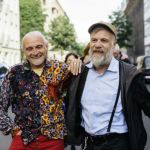Gittings and Lahusen took on many issues that other gay leaders thought were too big to tackle. But medical challenges for LGBTQ+ people still persist.
For author and journalist Tracy Baim, who wrote a book about early gay activist Barbara Gittings, there’s “nothing more important” in Gittings’ work than one moment in 1972, Baim told TODAY. Gittings’ longtime partner, Kay Lahusen, took thousands of photos of their efforts, but this one stands out.
In a generic conference room in Dallas, a psychiatrist speaks while Gittings, fellow gay activist Frank Kameny and a masked man sit calmly nearby.
‘Theater with intent’
The event was an American Psychiatric Association panel on the role of psychiatry for gay people in which Kameny and Gittings were invited to participate. The masked man, a psychiatrist then known only as Dr. H. Anonymous, famously spoke, with a voice changer, to his colleagues about being gay. Gittings and Lahusen had written letters and made phone calls, searching for someone like Dr. H., who later identified himself as Dr. John Fryer, to join the panel. They smuggled him into the event through back corridors.
At the time, even in the wake of the 1969 Stonewall riots, homosexuality was a diagnosable illness listed in the first two editions of the APA’s “Diagnostic and Statistical Manual of Mental Disorders,” often referred to as the “DSM.” Kameny and Gittings, with Lahusen by her side, had challenged mainstream medical thinking about being gay before, but the panel, thanks to Dr. H, was “theater with intent,” Baim said.
“It was practical because the diagnosis was used as a reason to keep people out of government jobs or the military or private industry or having custody of their children,” she explained. “The APA was an excuse that was legitimate because the APA was a legitimate organization.”
In advance of the panel, Gittings and Kameny handed out a statement called, “Gay, Proud and Healthy” and set up a display with the same title. The following year, in 1973, the APA voted to remove homosexuality from the “DSM.”
“‘I am a gay man, and I’m a psychiatrist.’ That audience had never heard a psychiatrist actually say it to them,” Dr. Saul Levin, current CEO and medical director of the APA, told TODAY. “The psychiatrists of APA became emboldened by what Barbara, Kay and Frank were doing and said this has got to end.”
In a 2006 speech about the panel, Gittings once said, “Many psychiatrists were used to thinking of us as miserable patients with troubled lives, and they needed to see some reality.”
A movement caught on camera
The APA panel was “the culmination of a decade of work that had been fighting every kind of bias that existed institutionally but a lot of gay people were afraid to take on both for their own careers but also because it felt like an impossible task,” Baim explained. “Barbara, Kay and Frank … never were intimidated by the size of these problems.”
There weren’t many gay activists using their names at the time when the trio was most active, she added.
Lahusen died in late May at age 91, just days before Pride Month 2021 kicked off. She’s credited with closely documenting the birth of the LGBTQ+ movement in the U.S. and is known as the country’s first openly gay photojournalist. The country’s first lesbian magazine, The Ladder, edited by Gittings, often featured her work. Lahusen also co-authored a book in 1975 under the pseudonym Kay Tobin, about the LGBTQ+ movement’s early leaders, called “Gay Crusaders.” Her photos, which document the gay rights movement years before Stonewall (and after), are in a collection at the New York Public Library
Gittings, known as the mother of the gay rights movement, and Kameny may’ve been bigger activist figures, but according to Baim, “there is no way Barbara Gittings would have accomplished the work or her work would have been as remembered without the support and and documentation of Kay.” The couple met in 1961 and stayed together until Gittings died in 2007 at age 74 of breast cancer.
Baim collaborated with Lahusen on Baim’s book, “Barbara Gittings: Gay Pioneer,” recalling, “Kay was both humble and proud at the same time.”
Lahusen thought her main legacy was her partner, who, among other accomplishments, founded the East Coast chapter of the country’s first national lesbian group, the Daughters of Bilitis. Gittings also worked with the American Library Association to make literature that framed being gay in a positive light more accessible.
In addition, Gittings and Lahusen attended with the latter photographing the first gay pickets at the White House in the 1960s and the July 4 Annual Reminder protests from 1965 to 1969 at Independence Hall in Philadelphia, where Gittings and Lahusen lived.
“There was nothing more important to (Kay) at the end of her life than to document their work in a book,” Baim said. “She knew how important it was to talk to multiple generations of gay people to pass on what she learned and the story.”
‘20,000,000 gay people cured!’
In the wake of the APA’s 1973 decision, many mainstream and LGBTQ+ newspapers covered the change. The Chicago Gay Reader went with a more snarky approach, an attitude that former Army Lt. Col. Ken Pinkela, who is gay, remembers seeing in gay people close to him.
At the time, Pinkela was a child, but he can still recall his gay godparents talking about it at a party.
“I have a vivid memory of that discussion because of the joke, ‘Oh, OK, now the shrinks say we’re not perverts,'” Pinkela, a spokesperson for SAGE, an organization for LGBTQ+ elders, told TODAY. “It was just, ‘Are you serious? We needed to have some group of psychologists telling us that we’re not perverts?’ I have an actual memory of them laughing and joking … kind of like a little celebration.”
Nancy Valverde, 87, was living as an out gay woman when the decision was made and remembers all too well when homosexuality was a diagnosable illness. She’s featured in a recent PBS documentary about gay elders called “Senior Prom.”
“Everybody said that the kids were crazy, we were all crazy,” she told TODAY. “I was raised to believe the doctor, the priest and the police, so I thought they were right. … I said, ‘No I can’t let that kind of thinking come into (my mind) because I am not crazy.'”
Valverde didn’t see much change for her after the APA decision but looking back, believes “every little bit counts,” she said.
When Levin, who is the first openly gay person to lead a medical specialty society, reflects on the decision, he thinks of the structural change it led to.
“People would argue this person is homosexual and should be put away in prison, should have these treatments put on them,” Levin explained. “It forced the courts to say no, the medical society said this is not an illness, and therefore, I’m not going to award what you want to have happen.”
Medical barriers for LGBTQ+ people today
While Kameny, Lahusen and Gittings’ activism paved the way for a society more inclusive of gay people, the work is not done, Amit Paley, CEO of The Trevor Project, which provides mental health services for LGBTQ+ youth, told TODAY. He pointed to conversion therapy, which is still legal in 30 states, and the ongoing laws and bills targeting trans youth.
“Some of the attitudes and statements of the mental health field for many years that there’s something wrong with being LGBTQ+, there are many people alive in this country today who grew up with those messages,” he said. “Many of them have evolved to change, and some people have not.”
Both the American Psychiatric Association and the American Medical Association have put out statements opposing conversion therapy and restrictions on gender-affirming care for trans youth.
Attitudes that there’s something wrong with being LGBTQ+, as the “DMS” suggested 50 years ago, still have a powerful effect on the community’s mental health, Paley added.
“Those messages impact the way that you think about yourself. If everyone is telling you that you are not worthy of respect, not worthy of love, for many people … those messages become messages of self-hate.”
When Pinkela came out to his family in 1993, the APA’s decision 20 years before played a role, especially in light of the discrimination he faced in the military.
“There was a level of personal validation,” he recalled. But, he added, “You don’t move that ship of cultural change overnight. We have to keep talking about it.”
During LGBTQ+ Pride Month, TODAY is sharing the community’s history, pain, joy and what’s next for the movement. We will be publishing personal essays, stories, videos and specials throughout the entire month of June. For more, head here.
This article was originally published in Today on June 16, 2021.







